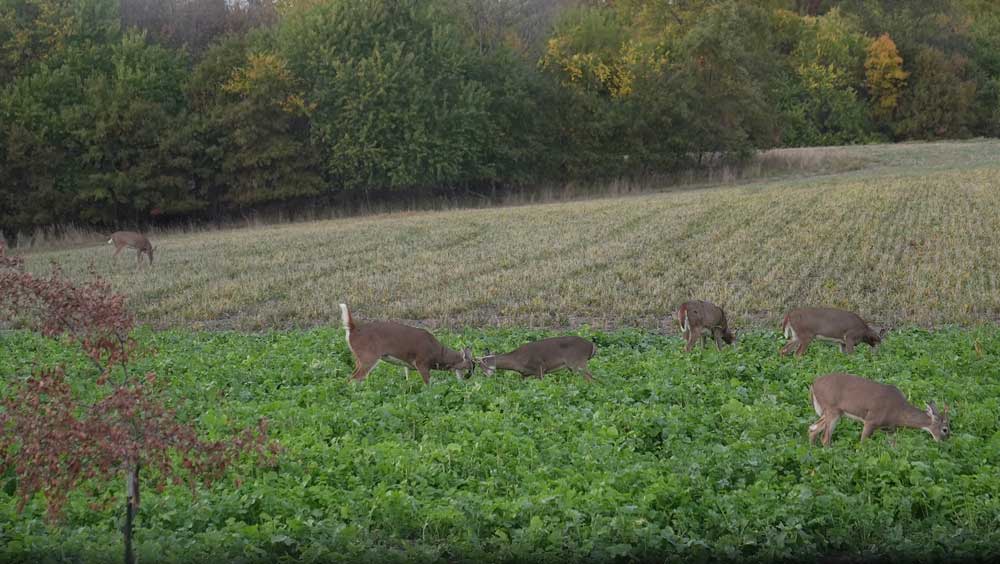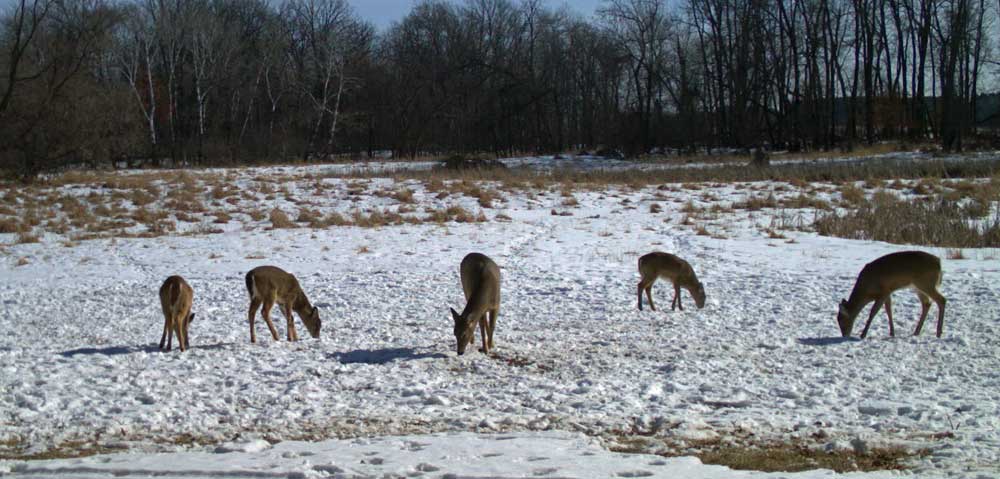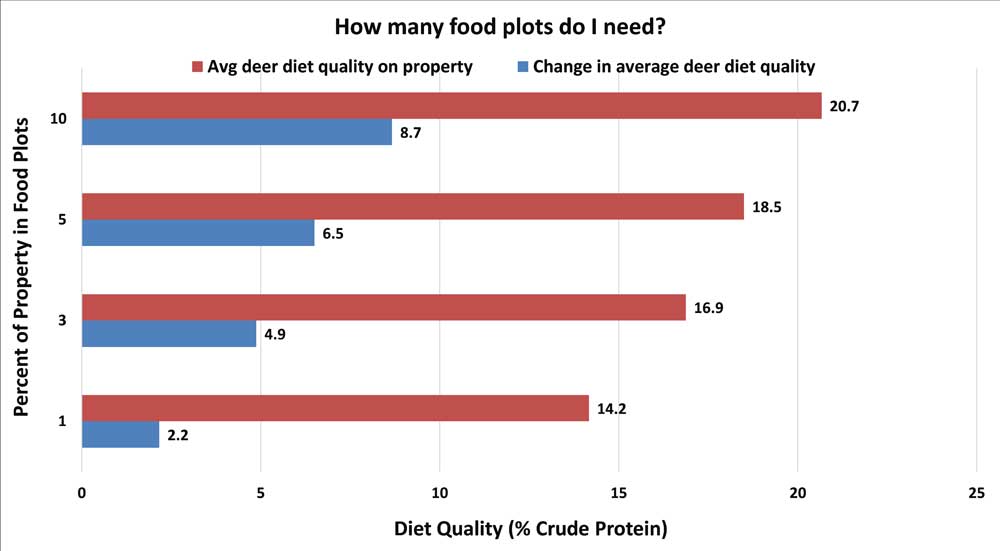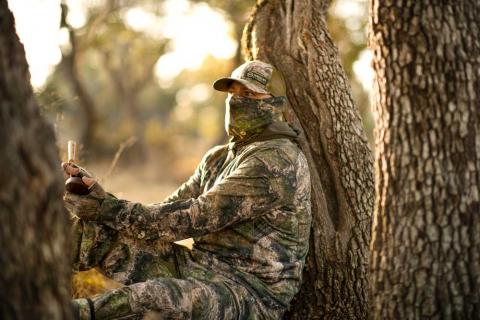Whitetail Science by MSU Deer Lab
How many food plots to I need to increase diet quality and size of my deer? It depends.

We can see the frustration in people’s eyes when there is no concrete answer to their question. Wildlife biologists commonly provide vague answers to questions they are asked because typically many factors must be considered to provide a “correct” answer. Here is a good example:
“How many does should we harvest on our property?” We will provide the answer, “it depends.” Sometimes we see the person asking the question rolling their eyes as if to say, “Here we go again, no straight answer.” However, these types of questions require so much qualification; in other words, the right answer depends on many conditions. Another very common question is, “How much of my property should be in food plots?” You know what the answer is. You guessed it, “it depends.”
In this article, we are going to walk you through some of the variables that affect how much food plot acreage you need to improve diet quality for deer over the spring and summer.
First, you must consider your goals for the property and deer herd. Do you simply want to see more deer and increase harvest opportunities, or do you want to improve nutrition with hopes of growing larger deer, improve reproduction, and increase age-specific antler size? Another factor you must determine is what you are starting with in terms of habitat quality relative to the number of deer using your property. For example, is the property you manage solid forestland or are you located in an agricultural region with an abundance of soybeans and winter wheat? Are you willing to spend the time and money to grow effective warm season food plots?
With deer diet quality, protein gets all the attention. Digestible energy and minerals are also very important for good deer nutrition, but we will stick with protein for this article. Research has shown repeatedly that an average diet of 16-18 percent protein is sufficient for meeting a deer’s growth needs. This is truly a case of more is not better because when average protein exceeds 18 percent, the extra is converted to urea and secreted in urine.
The most common deer food plot forages provide anywhere from 18 to 30-percent crude protein, depending on the growth stage of the plant. Examples would be oats, wheat, white clover, soybeans, and cowpeas. So let’s assume an average of 25-percent protein for our analysis. If we want to determine how much food plot acreage you need to raise the average diet quality on your property to 18 percent, you need to know the average diet quality of the forages provided by your deer habitat – that is, the amount and quality of naturally occurring foods in the woods and fields. Luckily, numerous studies have measured the amount and quality of common deer forages (like pokeweed, beggar’s lice, ragweed, greenbrier, and blackberry).

The amount of deer forage available is directly related to the amount of sunlight that reaches the ground. Within the Southeast, the amount of sunlight reaching the ground depends primarily on forest management. Think of the amount of vegetation on the ground following a clear cut; it can get so thick it is hard to walk through. Although it is difficult for humans to move through that stuff, wildlife love it! Deer, rabbits, turkey, and bobwhite quail all depend on these natural plants for both food and cover. As the forest stand ages, you slowly see the amount of ground vegetation diminish. This is because the canopy of the trees is capturing sunlight and little reaches the ground. Following the first thinning, you see the cycle repeat – more sunlight reaches the ground, and thus more ground vegetation.
Now back to the original question. What’s the average diet quality of a typical forest? The average amount of forage on your property can range from less than 100 pounds per acre to over 700 pounds per acre depending on the stage of forest growth, the number of thinned stands, and recent clear cuts. We decided to use an average of 250 pounds of deer forage per acre for simplicity.
Now that we know the average amount of deer forage on the forested landscape, we need to determine the dietary quality of this forage. As you can guess, this depends on the species of plants growing in your forest. Protein has been measured as high as 30 percent for plants like pokeweed, and down to 7 percent for other forages. Again, when you look at the average of all these forages it amounts to about 12 percent. Now we have the identified the crucial variables necessary to answer our question: how much food plot acreage do you need?
Let’s say you hunt and manage a 500-acre property that is composed primarily of forest land. Using our average habitat values discussed earlier, your property would have about 250 pounds of deer forage per acre with a protein content of 12 percent. So how many pounds of food plot forage should you provide to raise the average diet quality from 12 to 18 percent? Some quick math will provide our answer: 500 acres x 250 = 125,000 pounds of deer forage, but only 15,000 pounds of protein (125,000 x 0.12). Therefore, to raise the average diet quality to 18-percent protein on the property you would need to add 107,000 pounds of food plot forage. Or, 26,750 pounds of food plot protein (107,000 x 0.25).

Another way to ask the same question would be, “How much food plot acreage do I need on my 500-acre property?” If you keep all the same assumptions about deer habitat quality as well as food plot quality, you will see in Figure 1 that between 3 and 5 percent of the property should be in food plots. For these results to hold true, your food plots must be producing the maximum amounts, that is, plots are limed and fertilized according to a soil test to achieve maximum growth. If weights and antler size indicate your deer are not achieving maximum growth, you will need more acres.
We hope this quick demonstration has provided some clarity regarding how much food plot acreage you need to improve the average diet quality. We made a lot of assumptions because every property is different (it depends). We suspect some readers will be encouraged by these results, whereas others will not. You may be in a situation where you can’t have 3 percent of your property in food plots due to landowner agreements or topography restraints. In that case, we recommend you focus on lowering deer density. If you are interested in quality deer, it’s better to have fewer deer with more high-quality food available to them.




























